Umbrella Plant (Schefflera): Caring for Dwarf Umbrella Tree

The umbrella plant (Schefflera arboricola or Heptapleurum arboricola) is a popular tree like houseplant that is easy to grow indoors. Other common names for this tall houseplant include dwarf umbrella tree, parasol plant, octopus tree, and dwarf Schefflera. The umbrella plant makes for a tall, ornamental indoor tree-like plant that grows in containers. Its large leaves and bushy foliage are just some of the reasons why the Schefflera plant tops the list of trendy houseplants.
How to care for dwarf umbrella plant: The Schefflera arboricola grows like a small indoor tree in bright filtered light, a well-draining potting mix, and average humidity. Water the tropical umbrella plant when the top layer of soil dries, mist the leaves occasionally, and feed monthly during the growing season. Growth rate of Schefflera is best in temperatures between 60°F and 75°F (15°C – 24°C).
The Schefflera arboricola is a species of flowering plant that is native to Taiwan. However the dwarf Schefflera plant rarely flowers indoors.
The umbrella plant is the dwarf variety of the Schefflera tree and is related to the large Schefflera actinophylla which is also called the Australia umbrella tree.
The dwarf umbrella tree grows as an attractive houseplant and rapidly reaches between 4 and 8 feet (1.2 – 2.4 m) tall.
The type of leaves on this tree like umbrella plant are palmate, meaning there are 7 – 9 leaflets growing from a single point. Its foliage is mostly green, and some cultivars have variegated leaves with green and creamy-white or yellow patterns.
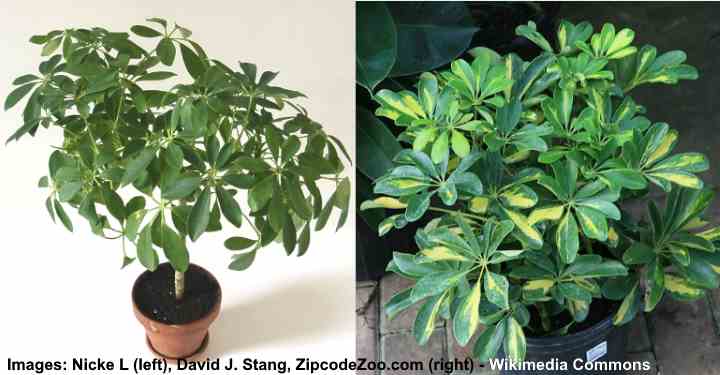
The Schefflera arboricola (dwarf umbrella tree) includes several cultivars, some with variegated leaves
The reason why dwarf Schefflera plant is called umbrella plant is due to how its unusual leaves are arranged like an umbrella. The groups of leaflets grow circularly at the end of stems and this gives the leaves a look of an umbrella.
In this article, you will find out how to care for the umbrella plant (Schefflera arboricola). You will also learn how to resolve some issues that arise when growing this plant indoors.
How to Care for Umbrella Plant (Schefflera arboricola)
Dwarf umbrella trees are not fussy when it comes to care. These houseplants grow well in most indoor environments. With medium light and watering a couple of times a month, you can grow umbrella plants in rooms or offices.
Let’s look in more detail at how to look after a Schefflera plant.
Light Requirements for Growing Dwarf Umbrella Tree Indoors

Grow your schefflera plant in bright indirect light
For fast growth, place umbrella plants in bright light, but protect from direct sunlight. Plenty of light helps the plant to grow straight, just like a tree. Light also helps foliage to be plentiful and bushy so that your umbrella tree-like plant has a lush, healthy appearance.
Good indirect sunlight is also essential for variegated dwarf umbrella tree cultivars. So, if you have the Schefflera ‘Gold Capella,’ ‘Green Gold,’ or ‘Trinette,’ make sure that there is enough light. A lack of light causes the beautiful shiny foliage to become pale and lose its vibrancy.
Although dwarf Schefflera plants can tolerate low light, their growth rate will be slow. You may also end up with a tree-like plant that has crooked or bent stems. Growing in poorly-lit rooms, bathrooms, or complete shade can result in leggy growth with sparse foliage and a scruffy appearance.
The Best Potting Soil for Umbrella Plants
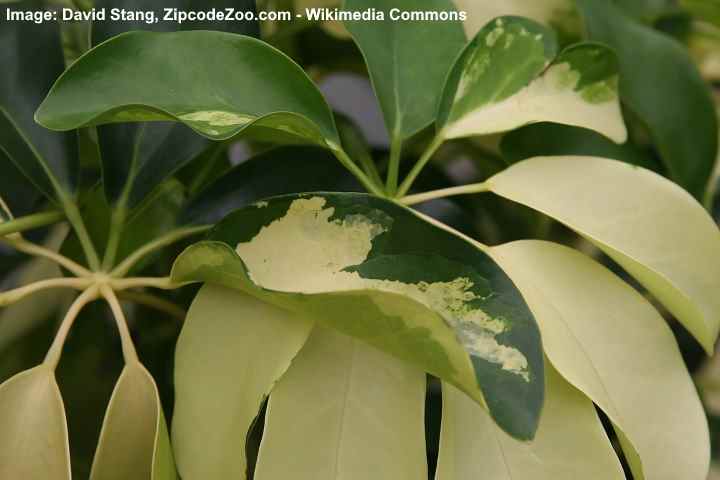
Schefflera plants need a well draining soil with plenty of organic matter
Schefflera arboricola plants thrive in a potting mix with plenty of organic matter that has excellent drainage. The ideal type of growing medium should have two parts of peat moss and one part perlite. The crucial care factor for umbrella plants is that the potting soil retains some moisture without ever being soggy or damp.
You can also make an appropriate potting mix by combining equal quantities of humus, garden soil, and perlite or coarse sand. Using perlite improves drainage, whereas organic substances stay moist. To prevent soil from becoming waterlogged, it is vital to use a pot with drainage holes.
Umbrella Plant Water Requirements
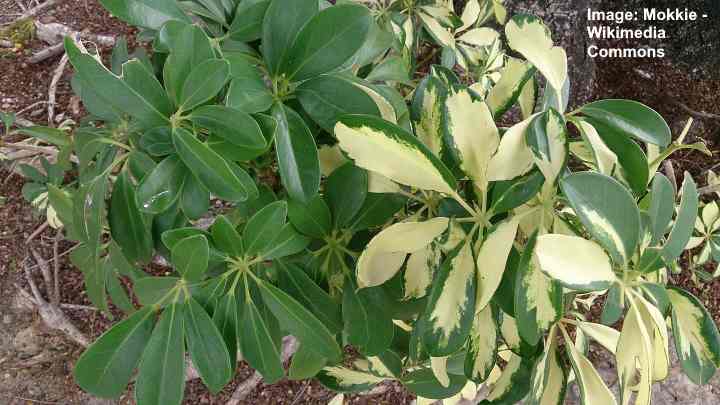
To care properly for your dwarf umbrella tree, water it when the top soil has dried out
The best care advice for growing dwarf umbrella trees at home is to water when the top layer of soil is dry. During summer, you should water an umbrella plant as often as every week and less often in the winter. To water umbrella plants, thoroughly drench the soil and allow the excess water to drain completely.
Soaking the soil allows enough moisture to penetrate the roots. This type of hydration enables the plant to thrive in any condition—as long as you only water when the top section of soil has completely dried. Always empty water from a drip tray to prevent the soil from sitting in water.
Avoid the common mistake of watering your houseplants on a schedule. Each type of plant absorbs water at a different rate. Also, warm temperatures and changes in humidity can affect how often you should water umbrella plants. In winter, you will need to water the plant less frequently than in summer.
For excellent advice on houseplant care, please read this article on how often to water indoor plants.
Temperature for Growing Schefflera Arboricola
Dwarf umbrella plants thrive in a temperature range between 60°F and 75°F (15°C – 24°C). So, the tropical houseplants will grow well in average room temperatures. Umbrella plants that have dark green foliage can survive better in cooler temperatures. The variegated cultivars need to grow in warmer temperatures.
Dwarf umbrella trees are quite sensitive to the cold. Schefflera arboricola plants grow outdoors in USDA zones 10 and 11 as long as they are planted in partial shade. You can also take umbrella plants outdoors in summer if you live in temperate climates. But, you have to be careful that the outside temperature doesn’t drop below 55°F (13°C), or the leaves could start falling.
What is the Right Humidity for Indoor Umbrella Plants?
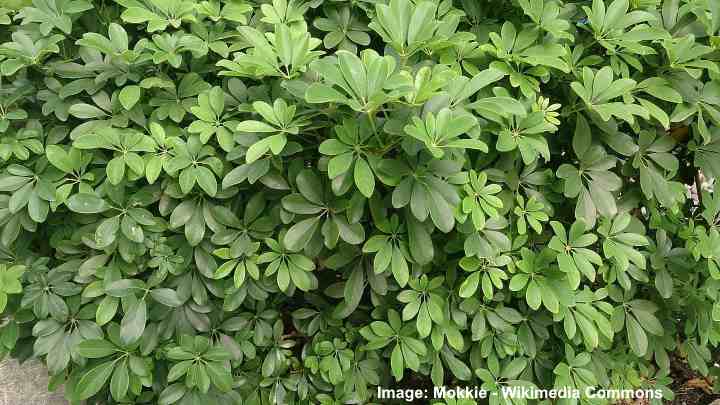
Schefflera arboricola (or Heptapleurum arboricola) plants grow well in average indoor humidity with occasional misting
Dwarf umbrella trees are native to warm, humid environments. Although they adapt well to average indoor humidity, they benefit from an occasional misting. You could also use a room humidifier or pebble water tray to increase air moisture. Another way to humidify umbrella plants and keep them looking good is to wipe the leaves with a damp cloth.
When growing indoors, dwarf umbrella plants are susceptible to pests such as spider mites and scale. Keeping humidity levels above 50% can help to keep these sap-sucking pests at bay.
Getting humidity levels right can be challenging in winter when heating tends to dry out the air. During winter, when growth slows to a minimum, you need to water less and stop fertilizing. However, regularly misting the plants can keep them looking healthy and vibrant.
How to Fertilize Umbrella Plants
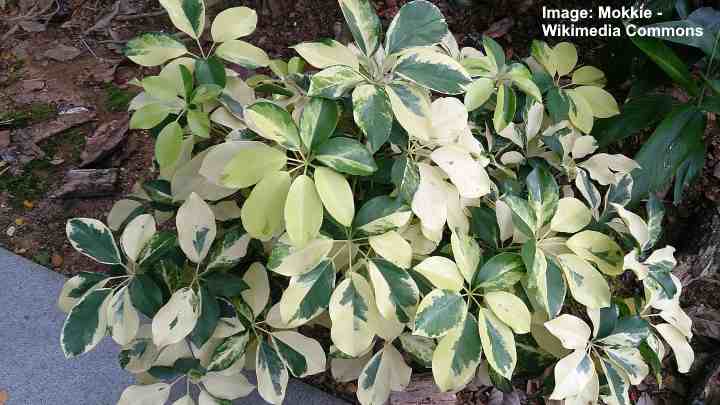
Fertilize your Schefflera every 2-4 weeks during spring and summer
Dwarf Schefflera plants need regular feeding during the growing season. These umbrella plants are fast growers and can put out a lot of new foliage in spring and summer. Use a regular houseplant fertilizer, diluted to half-strength. Apply the fertilizer every two weeks to encourage vigorous growth or every four weeks for average growth.
You should stop feeding the plant in the fall and winter. Because growth is dormant, adding fertilizer can cause root burn and even kill your plant. Another reason to hold off on feeding is when the tall indoor plant has reached its desired height.
Umbrella Plant Growth Rate
Dwarf umbrella trees are fast growers when growing in the right conditions. Bright light, regular watering, and feeding every few weeks help to boost its growth rate. During the growing season, umbrella plants can grow an impressive 3 ft. (0.9 m) every year. You may be surprised at how fast this plant grows in one season.
Of course, growth slows down in winter, and this is normal. If there seems to be little growth in spring and summer, you should check the growing conditions. A slow-growing pace could also mean that the plant has become rootbound and needs repotting.
Under ideal conditions, the tree-like plant can eventually grow up to 6 feet (1.8 m) indoors with a relatively slender spread of up to 2.5 feet (75 cm).
Schefflera Arboricola Flowers
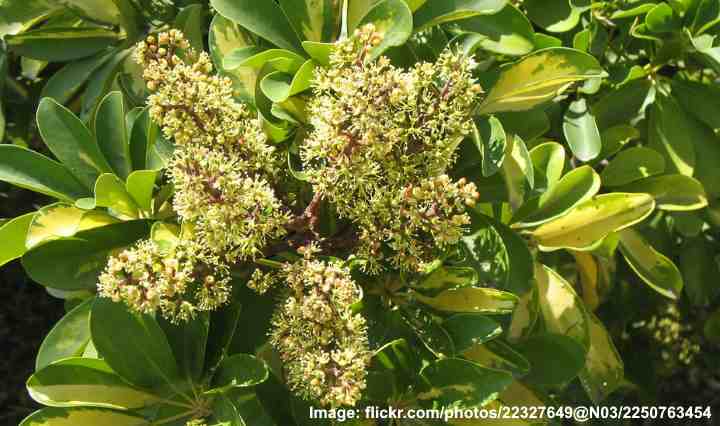
The umbrella plant rarely flowers indoors – its flowers look like compact white spikes and they are arranged in clusters.
Umbrella plants rarely flower indoors and these dwarf trees are mainly known for their showy foliage. The dwarf Schefflera plant has small flowers that look like small white spikes as seen in the picture above. The dwarf Schefflera flowers grow in clusters that have impressive appearance.
Umbrella Plant Leaves
People grow a dwarf Schefflera plant for its impressive foliage because it rarely blooms indoors. If you want an impressive umbrella plant, choose one of the yellow and green or white and green variegated cultivars. Some plant species have fascinating leaf markings that can create a stunning vertical accent in a room or office.
Pruning an Umbrella Plant
Pruning a Schefflera plant indoors is vital to keep it at a manageable size. You should also prune leggy stems or dead foliage to improve the plant’s aesthetics. Their fast growth means that new stems and leaves grow back quickly. All you need to do is pinch back leggy stems just above the node.
Regular trimming during the growing season also helps to promote bushy, compact growth. You should prune back unwanted growth to make the plant grow more like a bushy indoor shrub rather than a large tree. If the plant gets too big for your room, you can trim back the main branch to control its size.
How to Propagate Schefflera
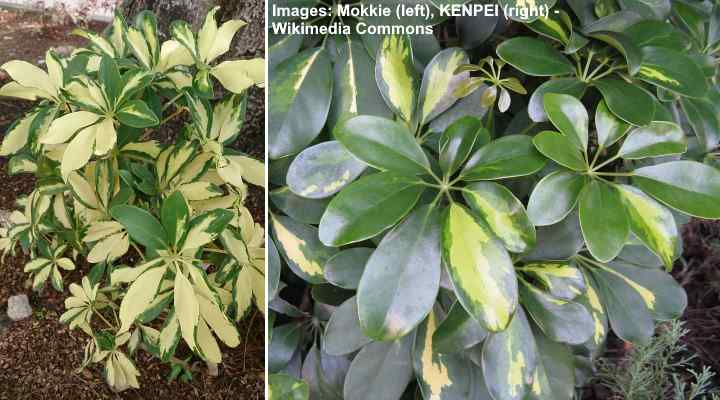
Schefflera plant can be easily propagated by stem cuttings. In these pictures: variegated Schefflera cultivars
The easiest way to propagate dwarf umbrella trees is by stem cuttings. You should cut a stem just below a node so that it is 4” to 6” (10 – 15 cm) long. Remove the bottom leaves so that 3 – 4 leaves are left on the cutting and dip the end node in a rooting hormone. Put into a moist potting mix and place in a warm, humid place.
Another way to root stem cuttings is to put them in a jar of water. Place the jar in a warm, bright place, and after a few weeks, roots should start to appear. Transfer to a pot that has moist, well-draining potting soil.
Repotting Umbrella Plants Indoors
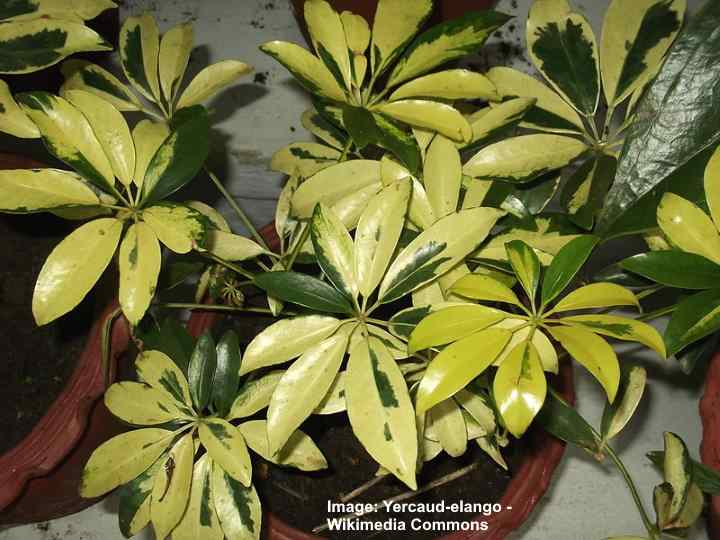
Repot your Schefflera arboricola plant every 2-3 years to encourage healthy growth
Every two or three years, it’s necessary to repot a dwarf Schefflera plant. Repotting umbrella plants helps encourage growth and prevents the plant from becoming rootbound. Usually, the signs that a dwarf umbrella tree needs replanting include roots poking out the drainage holes or slow growth.
When choosing a new pot for a dwarf umbrella tree, choose a heavy terracotta one. The extra weight gives stability to the plant and prevents it from falling over. A new container should be one or two sizes larger than its current one.
Here are the steps to repot an umbrella plant growing at home:
- Gently remove the dwarf umbrella tree from the pot.
- Separate the tangled roots and remove all excess dirt.
- Check for signs of root rot such as brown, mushy roots.
- Half-fill the new container with the appropriate potting mix.
- Plant the umbrella shrub at the same height in its new pot.
- Fill up the remaining space with the remainder of the fresh potting soil.
- Thoroughly water the plant and wait until the soil partially dried before watering again.
- Because the fresh potting mix is rich with nutrients, wait for six to eight weeks after repotting before fertilizing.
Pests and Diseases Affecting Dwarf Umbrella Tree Growth

Use neem oil solution to quickly get rid of pests on your dwarf umbrella tree
Common houseplant pests often affect umbrella plants, and spider mites, scale, and aphids are the most typical culprits. Tiny insects can quickly infest a Schefflera plant and cause the plant to wilt and eventually die. It’s crucial to spot the first signs of indoor plant pests and eradicate them as soon as possible.
A lack of humidity can sometimes attract spider mites and scale insects. So, as a preventative measure, keep dwarf umbrella trees in medium to high humidity. However, if pests infest your plant, use a neem oil solution or insecticidal soap to get rid of the bugs quickly.
Related reading: How to get rid of houseplant pests fast and safely.
Are Umbrella Tree Plants Toxic?
Plants in the genus Schefflera are toxic to cats and dogs. The American Society for the Prevention of Cruelty to Animals (ASPCA) says that Schefflera plants contain poisonous substances called calcium oxalate crystals. These toxins can cause oral irritation, excessive drooling, and vomiting if pets swallow parts of umbrella plants (1)
FAQs About Growing Umbrella Plant (Schefflera arboricola) Indoors
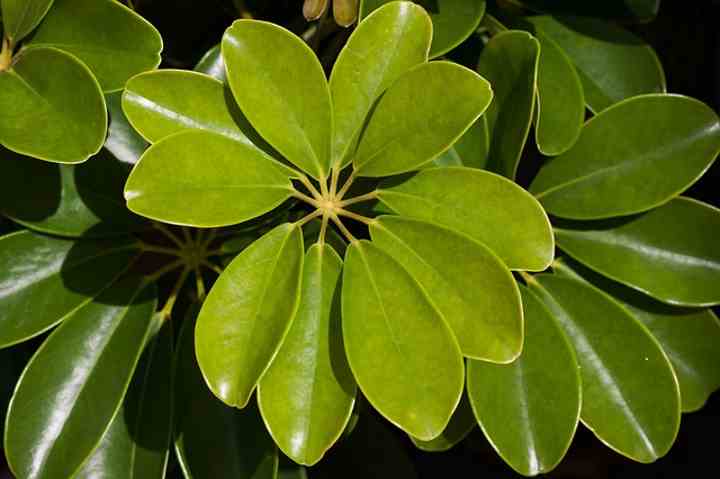
Why is my umbrella plant dropping leaves?
Leaves may start to fall from the Schefflera plant if you are over-watering or under-watering the plant. So, check the soil for moisture and only water when the top 1” to 2” (2.5 – 5 cm) of soil is dry. Other reasons for dropping leaves are temperature extremes, poor light, or moving the plant around too much.
How can I stop my dwarf umbrella tree from falling over?
Umbrella plants quickly grow into tall tree-like plants indoors. Because this is a multi-stemmed shrub, they can sometimes become top-heavy or fall over. You can improve stability by growing the small tree in a terracotta pot. Or, you could tie the stems loosely together to prevent the plant from keeling over.
Why are umbrella plant leaves turning yellow?
Naturally, older leaves on houseplants like Schefflera turn yellow before falling off. However, many leaves turning yellow at the same time on the crown could indicate another problem. The most common reason for yellowing leaves is over-watering. But high heat, temperature fluctuations, and under-watering can all result in leaves turning yellow.
Why is my umbrella plant got sticky leaves?
Sticky substances on the leaves of your Schefflera are usually a sign of a pest infestation. Mealybugs, scale insects, and aphids can suck the plant’s sap, which is then excreted as a sticky, honeydew substance. It’s essential to treat houseplant pests as quickly as possible. Apart from your plant dying, the insects can infest other plants in your home.
Why has my umbrella plant stopped growing?
Schefflera plant growth becomes dormant in winter, and you shouldn’t expect it to grow much. If growth slows down and leaves turn pale at other times of the year, it could be due to feeding issues. Apply a diluted houseplant fertilizer once a month from spring until the end of summer.
How to avoid crooked or bent stems when growing dwarf umbrella trees
Umbrella plant stems can start growing crooked if there is not enough light. Stems grow towards the light. So, if the light only comes from one source—such as a window in a dimly-lit room—the stems will bend and lean towards the light. To prevent crooked stems, place your Schefflera plant in bright light and rotate the plant every so often so that the light is even.
Related articles:
